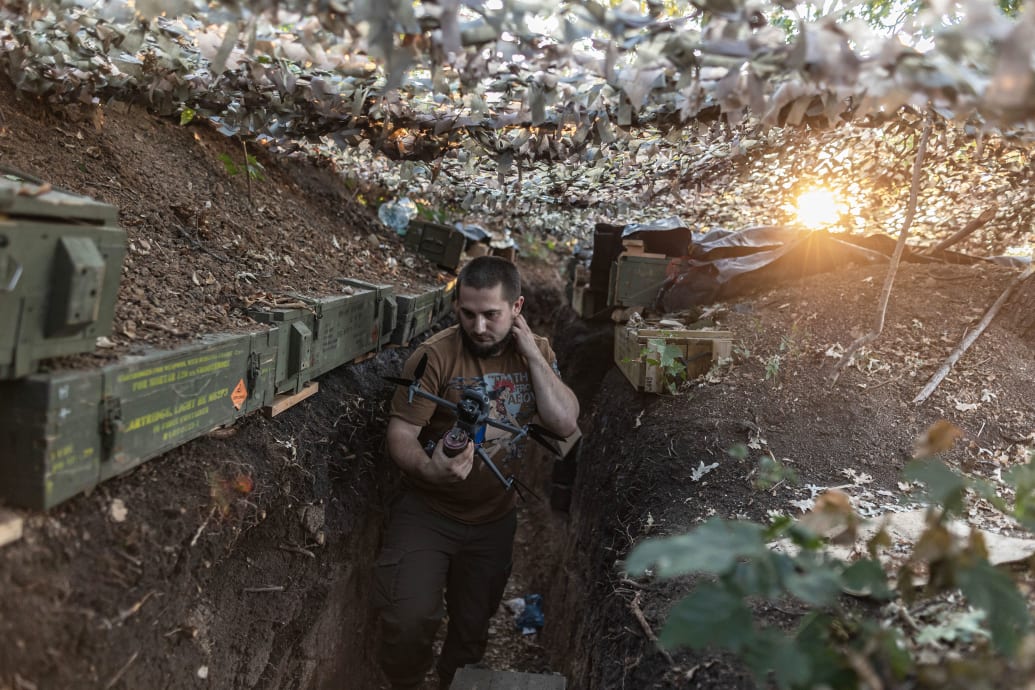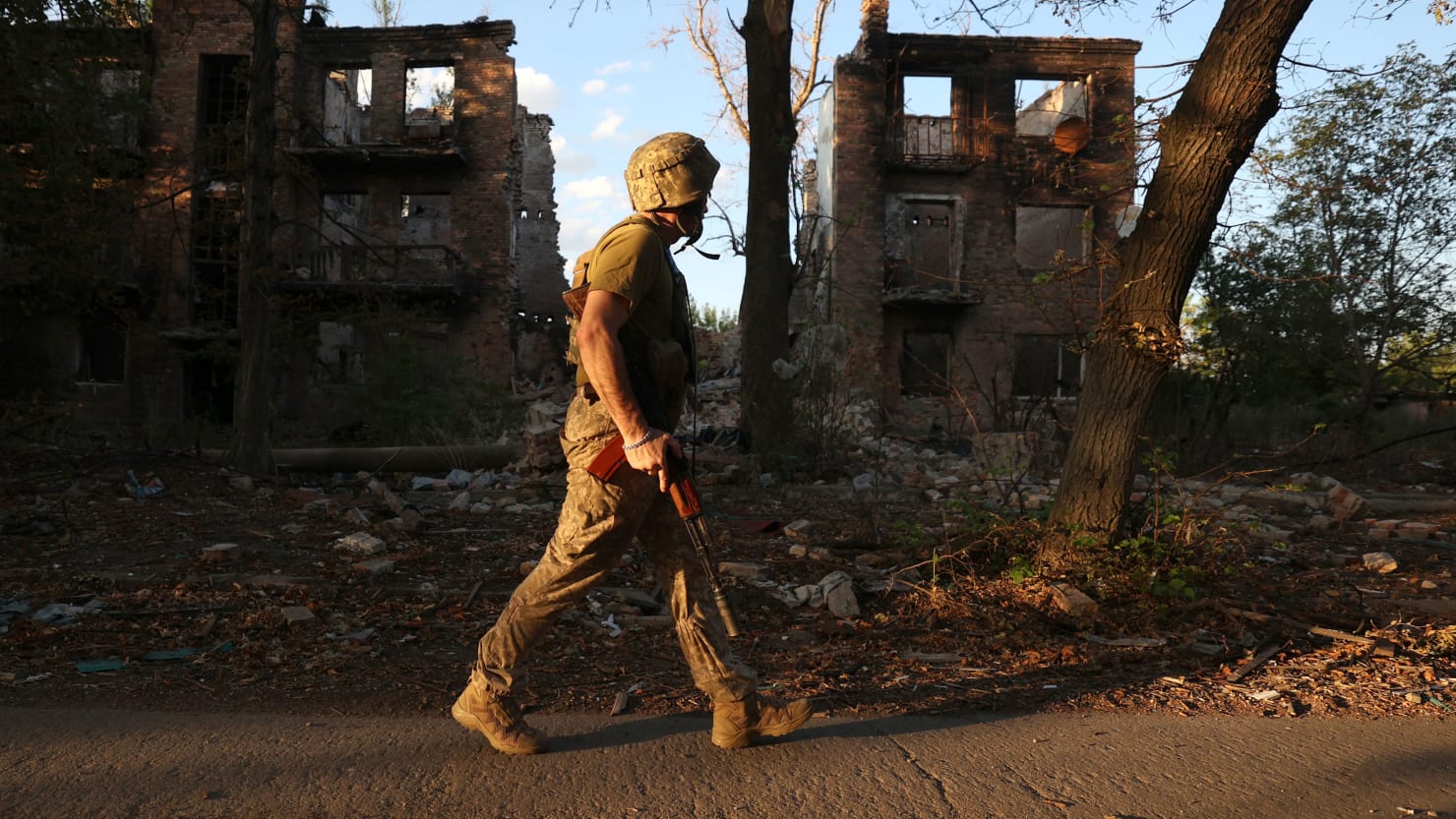KYIV—After years of holding the line, the Ukrainian front in Donbas looks to be falling apart. Despite Ukraine’s successes in the Kursk region, the Russians have accelerated their advance towards the key city of Pokrovsk.
They are now less than seven miles from the city gates. Tatargami, a Ukrainian officer, posted a Twitter thread where he blamed “delayed mobilization… ineffective recruitment and awful commanding culture.”
While the West has contributed to Ukraine’s failings with slow aid deliveries and needless restrictions on weapons systems, critics say the buck must ultimately stop with Ukraine’s political and military leadership.
Soldiers on other parts of the front gave similar assessments. “I had to buy all my gear myself,” a soldier I’ll call Vadim, a sniper fighting in Eastern Ukraine, told me as our sleeper train pulled out of the Ukrainian capital for the northeastern city of Kharkiv.
It was back in March, and what he was telling me was a portent of what was to come in the region. “What we were given was shit—I bought my own night vision, silencers, body armor,” he said.
Vadim used a combination of his own savings and crowdfunded donations from family and friends to make up the difference. As the fighting dragged on, he said, the Ukrainian war effort was falling victim to incompetence and graft. Corrupt officers would skim money off the top for better gear meant for their troops, and men would pay bribes to avoid military service or even flee the country.
When Russian troops pushed through poorly prepared defenses near Kharkiv earlier this month, Vadim had an ‘I told you so’ moment. “They didn’t build anything, because of corruption. They stole [the] money,” he texted me. He offered no proof of this, but it is a sentiment that has taken hold across much of Ukraine.
“Corruption is the most serious problem we have throughout our military”, said Roman, another soldier fighting in the Kharkiv region. “But you don’t write much about it overseas.”
Yet after initial Russian advances, the Ukrainians rushed reserves to Kharkiv, held the line, and kept the Russians out of artillery range of Kharkiv city. Other soldiers have noted that the Ukrainians could not have constructed an adequate defense line directly on the border, being right under the range of Russian guns, so the Russians never breached the main Ukrainian line of defense.
Still, the situation further south, in the Donbas region, has seriously deteriorated.
President Volodymyr Zelensky even fired a senior Ukrainian commander after repeated complaints from the troops serving under him, accusing him of mismanagement that led to many unnecessary deaths.
There have been improvements in the situation for Ukrainian troops this year. An influx of weapons and a long-delayed mobilization of young men has helped reinforce troops at the stretched front lines. Changes in U.S. policy have also allowed Ukraine to use American weapons to strike targets directly inside Russia itself. This has helped Ukraine stymie Russia’s offensive in Kharkiv.
Still, Ukraine is facing wider problems in its military—it doesn’t have enough troops, and many of those who still serve are getting increasingly fed up. Many of the most patriotic Ukrainians who did sign up in those early months now feel that they have got a raw deal. They’ve been on the front lines for two years while their less courageous compatriots have been able to carry on relatively normal lives in safe cities.
As a holder of a European passport, Vadim could have easily found a way to leave Ukraine and live abroad, but felt it was his duty to fight. But frustration with their government—lack of equipment, incompetent commanders and no rotation with other units—have driven some soldiers to breaking point. “There are armed men that, as soon as we are finished with the Russians, are going to march on Kyiv” Vadim says.
“I joined in April 2022, after my hometown in Kyiv region was liberated,” said another Ukrainian soldier fighting in the Kharkiv region. His commander had signed up in late 2014, during the first war when Russian forces invaded the Donbas region in Eastern Ukraine. Another was from occupied Kherson and had joined after the liberation of his city at the end of 2022. Almost none of the solders The Daily Beast spoke to had been recently called up. Every man was exhausted, their eyes bloodshot with heavy bags, much of their gear old and rusting. They are surviving on starvation rations of artillery shells, often a tenth as much as the Russians are firing, and an inconsistent supply of drones and makeshift explosives.

Ukrainian soldier carries a drone in a trench in the direction of Bakhmut as the Russia-Ukraine war continues in the Donetsk Oblast, Ukraine on August 10, 2024.
Diego Herrera Carcedo/Anadolu via Getty Images
There is a growing divide in Ukraine between those who have fought in the war, and those who have not. When Russia invaded Ukraine in February 2022, Mathew enlisted to join the Ukrainian army, while his best friend paid a bribe to flee the country. “He’s dead to me” Mathew, a soldier with Ukraine’s Third Assault Brigade, told me while we waited near a field hospital near Kostyantinyvka in eastern Ukraine. “My friends are all here now”. The road leads to the cities of Bakhmut and Chasiv Yar—the former destroyed and occupied last year, the latter under heavy Russian bombardment.
“Let’s be honest, I would not join the military in 2024”, Alina Sarnatska, a former Ukrainian soldier posted on X. “Military personnel have the fewest rights in Ukraine… Most expected to be in military status temporarily or to be demobilized in a year and a half… The military now openly say that there are only two ways out of the army—injury or death.”
A recruitment poster on the road we pass leading to Kharkiv reads, ‘Father, what did you do in the war?’, while others feature the faces of Ukrainian soldiers fallen in battle, with taglines like ‘He gave his life so you can live’ and, ‘He died for your freedom’. All have contact numbers and links for potential recruits interested in signing up. But, as all frontline troops will tell you, anyone who wanted to join the army did so a long time ago. When Ukraine was consistently liberating territory and was well supplied with Western weaponry, joining the military seemed a better deal. Now, with stories of soldiers holding the lines for two years with no respite, and a well-known ammunition shortage, service in the Ukrainian military no longer looks like an attractive prospect. More than 600,000 men have fled overseas according to a BBC Ukraine report, despite a ban on men between the ages of 18 and 60 leaving the country.
With no end to the war in sight, some Ukrainians see military service as, at worst, a death sentence, at best an endless trench nightmare. It is the same on other parts of the front. One brigade in the Zaporizhzhia region that had been involved of the liberation of Robotyne was then forced to defend the town from Russian counterattacks for nearly six months before a fresh brigade came in to replace them.

Ukrainian soldier carries a drone in a trench in the direction of Bakhmut as the Russia-Ukraine war continues in the Donetsk Oblast, Ukraine on August 10, 2024.
Diego Herrera Carcedo/Anadolu via Getty Images
Experts have pointed to three key factors that have allowed the Russians to advance in the Donbas recently. The first is the lack of ammunition, which will likely soon be alleviated by the U.S. Congress’s belated decision to pass $61 billion in aid to Ukraine. Another is the lack of fortifications behind the front lines, like the Russian ‘Surovikin Line’ in Zaporizhzhia that was responsible for stopping last year’s Ukrainian counteroffensive. Officials say that this too is being sorted out, and the areas behind Ukrainian lines are now full of excavators and trench diggers preparing fortifications.
But the lack of manpower is a more difficult issue. After months of wrangling, Ukraine finally passed a law allowing men between the ages of 25 and 27 to be drafted and mobilized, and trying to improve the conditions of soldiers who can fight. But they will need to be found, trained, and equipped before they can be sent to the front lines, and even then will likely need to replace the exhausted soldiers who have been holding the fort for two years.
Moscow’s manpower advantage is nearly 2 to 1 and its artillery advantage is even more significant. “Manpower has become the most pressing issue” Rob Lee, a senior fellow at the Philadelphia-based Foreign Policy Research Institute, tweeted earlier this year. “Ukrainian brigades are understrength, and Ukraine lacks sufficient reserves to respond to Russian advances… The issue has been known for some time but it has not been fixed.”
Vadim says he and other soldiers on the front line remain grimly determined, but their hopes of a quick victory have faded completely.




![Tyson Foods Plant [Photo: Food Manufacturing]](https://southarkansassun.com/wp-content/uploads/2023/08/iStock_1185520857__1_.5e441daa51cca-600x337.jpg)







![Silverado Senior Living Management Inc. [Photo: Los Angeles Times]](https://southarkansassun.com/wp-content/uploads/2023/10/download-6-4-600x337.jpg)

![China's Wuhan Institute of Virology [Photo: Nature]](https://southarkansassun.com/wp-content/uploads/2023/09/d41586-021-01529-3_19239608-600x337.jpg)
















